Innovation Research on Symbiotic Relationship of Organization’s Tacit Knowledge Transfer Network
Abstract
1. Introduction
- (1)
- What are the specific influence factors in the tacit knowledge transfer process?
- (2)
- What are the symbiotic modes among members? Which one is the best mode?
- (3)
- What are the individual-related factors influencing tacit knowledge growth in the best mode?
2. Literature Review
2.1. The Influencing Factors of Tacit Knowledge Transfer
2.2. Organization’s Tacit Knowledge Transfer Network Research Method
3. Theoretical Framework
3.1. Conceptual Model of Organization’s Tacit Knowledge Transfer Network
3.2. The Process Model of Tacit Knowledge Transfer in an Organization’s Tacit Knowledge Transfer Network
4. Methodology
4.1. Model Hypothesis
4.2. Model Construction
4.2.1. Construction of Two Subject Evolution Model in Independence Phase
4.2.2. Construction of a Two Subject Evolution Model in Symbiosis Phase
4.2.3. Construction of Two Subject Evolution Model When Considering Organizational Rewards
4.2.4. Summary
4.2.5. Construction of Multi-Member Evolution Model
4.3. Stability Analysis of the Model and Symbiotic Modes Discussion
5. Model Simulation and Results
5.1. Commensalism Mode
5.2. Asymmetric Mutualism Mode
5.3. Symmetric Mutualism Mode
5.3.1. Impact of Maximum Scale
5.3.2. Impact of Natural Growth Rate
5.3.3. Impact of Initial Knowledge Amount
5.4. Impact of Correlation Coefficient on Evolution of Symbiotic Network
5.4.1. Impact of Provider’s Knowledge-Based Psychological Personal Ownership Coefficient
5.4.2. Impact of Media Richness Coefficient
5.4.3. Impact of Receiver’s Trust Coefficient
5.4.4. Impact of Organizational Rewards Matching Coefficient
6. Conclusions
6.1. Conclusions
- (1)
- Four levels have different influences on the evolution of tacit knowledge in the transfer process. By summarizing previous research conclusions, this article constructed a process model of tacit knowledge transfer within the symbiotic network and discussed the influence factors from four aspects: knowledge provider, knowledge receiver, media, and organization. This study shows that media richness, the receiver’s trust, and organizational rewards matching all contribute effectively to increased members’ tacit knowledge, but the provider’s KPPO inhibits the increase of members’ tacit knowledge. These are consistent with the conclusions of Wu et al. [18], Holste and Fields [23], Daft and Lengel [28] and extend the conclusion of Gagne [30]. The results show that a good atmosphere should be created to increase members’ trust and collaboration. An organizational reward mechanism should be built to meet different needs and stimulate sharing behavior. Furthermore, the media should ideally be enriched to reduce knowledge transfer loss.
- (2)
- Symmetric mutualism mode is the best mode between members. The result is consistent with the findings of previous studies. For example, Di and Dong [44], Ou et al. [46], and Yao and Zhou [47] opined that the mutualism mode is the best symbiotic mode. Through the analysis and discussion of all combinations of symbiotic coefficients, four symbiotic modes are determined. After the simulation of these modes, this study found that when in symmetric mutualism mode, knowledge subjects depend on each other and progress together. Their knowledge increments are equal. Organizational knowledge also increased because of members’ knowledge transfer. The symbiotic relationship among members is more stable, which is conducive to the organization’s sustainable development. The result shows that tacit knowledge transfer enjoys the influence of symbiotic relationships between members. Good relationships between them can significantly improve the efficiency of knowledge transfer. Thus, organizations should cultivate healthy and benign symbiotic relationships, promote knowledge subjects’ positive behaviors, and shape good behavior norms. Doing so helps to accelerate knowledge flow and sharing.
- (3)
- In the symmetric mutualism mode, the evolution of tacit knowledge is affected by three factors. In order to analyze the influence of individual-related factors on tacit knowledge transfer under symmetric mutualism mode, this article discusses the influence of the maximum level in independence, initial knowledge amount, and natural growth rate on tacit knowledge transfer. The maximum level represents knowledge self-learning ability, initial knowledge represents knowledge stock, and natural growth rate represents knowledge absorption capacity. This study shows that the maximum level in independence mode positively impacts the final stable knowledge level, and the initial knowledge amount and natural growth rate positively impact the growth rate of knowledge, respectively. The results indicate that the higher the self-learning ability, the higher the knowledge increment, the larger the knowledge stock or stronger absorption ability, the faster the knowledge growth rate.
6.2. Implications
6.2.1. Theoretical Implications
6.2.2. Practical Implications
6.3. Limitations and Further Research
Author Contributions
Funding
Institutional Review Board Statement
Informed Consent Statement
Data Availability Statement
Conflicts of Interest
References
- Cowan, R.; Jonard, N.; Zimmermann, J.B. Bilateral collaboration and the emergence of innovation networks. Manag. Sci. 2007, 53, 1051–1067. [Google Scholar] [CrossRef]
- Watson, S.; Hewett, K. A multi-theoretical model of knowledge transfer in organizations: Determinants of knowledge contribution and knowledge reuse. J. Manag. Stud. 2010, 43, 141–173. [Google Scholar] [CrossRef]
- Chen, Z.R. Study on the inter-organizational tacit knowledge transfer network. In Proceedings of the 5th International Conference on Computer Sciences and Convergence Information Technology, Seoul, Korea, 30 November–2 December 2010. [Google Scholar]
- Singh, N.P.; Stout, B.D. Knowledge flow, innovative capabilities and business success: Performance of the relationship between small world networks to promote innovation. Int. J. Innov. Manag. 2018, 22, 1850014. [Google Scholar] [CrossRef]
- Zhang, B.S.; Zhang, Q.P. Research on symbiosis relationship, evolution mode and simulation of member cooperation in tacit knowledge transfer network (Chinese). J. Mod. Inf. 2020, 40, 34–43, 53. [Google Scholar]
- Tran, Y.; Mahnke, V.; Ambos, B. The effect of quantity, quality and timing of headquarters-initiated knowledge flows on subsidiary performance. Manag. Int. Rev. 2010, 50, 493–511. [Google Scholar] [CrossRef]
- Isik, C.; Aydin, E.; Dogru, T.; Rehman, A.; Alvarado, R.; Ahmad, M.; Irfan, M. The Nexus between team culture, innovative work behaviour and tacit knowledge sharing: Theory and evidence. Sustainability 2021, 13, 4333. [Google Scholar] [CrossRef]
- Zhang, X.X.; Gao, C.Y.; Zhang, S.C. Research on the knowledge-sharing incentive of the cross-boundary alliance symbiotic system. Sustainability 2021, 13, 10432. [Google Scholar] [CrossRef]
- Adner, R. Ecosystem as structure: An actionable construct for strategy. J. Manag. 2017, 43, 39–58. [Google Scholar] [CrossRef]
- Bhawe, N.; Zahra, S.A. Inducing heterogeneity in local entrepreneurial ecosystems: The role of MNEs. Small Bus. Econ. Group 2019, 52, 437–454. [Google Scholar] [CrossRef]
- Cai, L.; Chen, J.Y.; Peng, X.Q.; Chen, B.A. The effect of symbiosis strategy on opportunity creation: Case study of new ventures in China. Int. J. Technol. Manag. 2016, 72, 171–191. [Google Scholar] [CrossRef]
- Zhou, H.; Han, X.R.; Wang, L. Characterization and evolution of a digital economy ecosystem based on an interspecies competition model. J. Math. 2022, 2022, 8237884. [Google Scholar] [CrossRef]
- Liu, K.; Wang, X.P.; Yan, Y.R. Network analysis of industrial symbiosis in chemical industrial parks: A case study of Nanjing Jiangbei new materials high-tech park. Sustainability 2022, 14, 1381. [Google Scholar] [CrossRef]
- de Azevedo-Martins, A.C.; Ocana, K.; de Souza, W.; de Vasconcelos, A.T.R.; Teixeira, M.M.G.; Camargo, E.P.; Alves, J.M.P.; Motta, M.C.M. The importance of glycerophospholipid production to the mutualist symbiosis of trypanosomatids. Pathogens 2022, 11, 41. [Google Scholar] [CrossRef] [PubMed]
- Pacheco, R.; Quinto, C. Phospholipase Ds in plants: Their role in pathogenic and symbiotic interactions. Plant Physiol. Biochem. 2022, 173, 76–86. [Google Scholar] [CrossRef]
- Kogut, B. The network as knowledge: Generative rules and the emergence of structure. Strateg. Manag. J. 2000, 21, 405–425. [Google Scholar] [CrossRef]
- Srivastava, S.B.; Banaji, M.R. Culture, cognition, and collaborative networks in organizations. Am. Sociol. Rev. 2011, 76, 207–233. [Google Scholar] [CrossRef]
- Wu, S.J.; Liu, G.X.; Liu, X.M.; Zhou, Z.B. How to promote knowledge sharing among E.V.C. members?—Based on interactive perspective of modified T.A.M. model. Eurasia J. Math. Sci. Technol. Educ. 2017, 13, 6313–6323. [Google Scholar] [CrossRef]
- Peng, H. Why and when do people hide knowledge? J. Knowl. Manag. 2013, 17, 398–415. [Google Scholar] [CrossRef]
- Bhattacharya, S.; Sharma, P. Dilemma between “It’s my or it’s my organization’s territory”: Antecedent to knowledge hiding in Indian knowledge base industry. Int. J. Knowl. Manag. 2019, 15, 24–44. [Google Scholar] [CrossRef]
- Tian, Y.; Mao, L.H.; Zhou, M.; Cao, Q.L. Knowledge-based psychological ownership and knowledge hiding: The roles of loss of knowledge power and emotional intelligence. Soc. Behav. Pers. 2021, 49, e10530. [Google Scholar] [CrossRef]
- Wang, Y.T.; Wang, Q.; Zou, Y.C. Trust internal competition and sharing procedural knowledge in teams (Chinese). Stud. Sci. Sci. 2010, 28, 1717–1721. [Google Scholar]
- Holste, J.S.; Fields, D. Trust and tacit knowledge sharing and use. J. Knowl. Manag. 2010, 14, 128–140. [Google Scholar] [CrossRef]
- Alexopoulos, A.N.; Buckley, F. What trust matters when: The temporal value of professional and personal trust for effective knowledge transfer. Group Organ. Manag. 2013, 38, 361–391. [Google Scholar] [CrossRef]
- Santoro, M.D.; Saparito, P.A. Self-interest assumption and relational trust in university-industry knowledge transfers. IEEE Trans. Eng. Manag. 2006, 53, 335–347. [Google Scholar] [CrossRef]
- Albino, V.; Garavelli, A.C.; Schiuma, G. Knowledge transfer and inter-firm relationships in industrial districts: The role of the leader firm. Technovation 1999, 19, 53–63. [Google Scholar] [CrossRef]
- Daft, R.L.; Lengel, R.H.; Trevino, L.K. Message equivocality, media selection, and manager performance: Implications for information systems. Manag. Inf. Syst. Q. (USA) 1987, 11, 355–366. [Google Scholar] [CrossRef]
- Daft, R.L.; Lengel, R.H. Organizational information requirement, media richness and structural design. Manag. Sci. 1986, 32, 554–571. [Google Scholar] [CrossRef]
- Super, J.F.; Li, P.S.; Ishqaidef, G.; Guthrie, J.P. Group rewards, group composition and information sharing: A motivated information processing perspective. Organ. Behav. Hum. Decis. Process. 2016, 134, 31–44. [Google Scholar] [CrossRef]
- Gagne, M. A model of knowledge-sharing motivation. Hum. Resour. Manag. 2009, 48, 571–589. [Google Scholar] [CrossRef]
- Husted, K.; Michailova, S. Diagnosing and fighting knowledge-sharing hostility. Organ. Dyn. 2002, 31, 60–73. [Google Scholar] [CrossRef]
- Elfring, T.; Hulsink, W. Networks in entrepreneurship: The case of high-technology firms. Small Bus. Econ. Group 2003, 21, 409–422. [Google Scholar] [CrossRef]
- Reagans, R.; McEvily, B. Network structure and knowledge transfer: The effects of cohesion and range. Adm. Sci. Q. 2003, 48, 554. [Google Scholar] [CrossRef]
- Li, Z.H.X.; Zhu, G.L. Knowledge transfer performance of industry-university-research institute collaboration in China: The moderating effect of partner difference. Sustainability 2021, 13, 13202. [Google Scholar] [CrossRef]
- Li, C.Y.; Hsieh, C.T. The impact of knowledge stickiness on knowledge transfer implementation, internalization, and satisfaction for multinational corporations. Int. J. Inf. Manag. 2009, 29, 425–435. [Google Scholar] [CrossRef]
- Wang, X.Y.; Xi, Y.J.; Xie, J.S.; Zhao, Y.X. Organizational unlearning and knowledge transfer in cross-border M&A: The roles of routine and knowledge compatibility. J. Knowl. Manag. 2017, 21, 1580–1595. [Google Scholar]
- Cummings, J.L.; Teng, B.S. Transferring R&D knowledge: The key factors affecting knowledge transfer success. J. Eng. Technol. Manag. 2003, 20, 39–68. [Google Scholar]
- Ning, Y.; Fan, Z.P. An empirical study on the context of tacit knowledge transfer in knowledge alliances. In Proceedings of the 2006 International Conference on Service Systems and Service Management, Troyes, France, 25–27 October 2006. [Google Scholar]
- Rotsios, K.; Sklavounos, N.; Hajidimitriou, Y. Successful knowledge transfer in I.J.V.s: The role of trust, partner compatibility and expected benefits. Eur. J. Int. Manag. 2019, 15, 595–614. [Google Scholar] [CrossRef]
- Huang, Y.H.; Yang, T.R. Exploring on-site safety knowledge transfer in the construction industry. Sustainability 2019, 11, 6426. [Google Scholar] [CrossRef]
- Zhao, J.; Zhu, C.J.; Peng, Z.X.; Xu, X.; Liu, Y. User willingness toward knowledge sharing in social networks. Sustainability 2018, 10, 4680. [Google Scholar] [CrossRef]
- Wang, S.Y.; Chen, W.M.; Wu, X.L. Competition analysis on industry populations based on a three-dimensional Lotka-Volterra model. Discret. Dyn. Nat. Soc. 2021, 2021, 9935127. [Google Scholar] [CrossRef]
- Taddeo, R.; Simboli, A.; Morgante, A.; Erkman, S. The development of industrial symbiosis in existing contexts. Experiences from three Italian clusters. Ecol. Econ. 2017, 139, 55–67. [Google Scholar] [CrossRef]
- Di, Q.B.; Dong, S.Y. Symbiotic state of Chinese land-marine economy. Chin. Geogr. Sci. 2017, 27, 176–187. [Google Scholar] [CrossRef][Green Version]
- Zhang, W.; Liu, P.F.; Zhang, J.K. Multi-group symbiotic evolution mechanism in an innovative ecosystem: Evidence from China. Rev. Cercet. Interv. Soc. 2019, 66, 249–277. [Google Scholar] [CrossRef]
- Ou, Z.H.; Zhu, Z.P.; Xia, M.; Chen, Y.T. The symbiotic evolution model of the innovation ecosystem and its simulation analysis (Chinese). Sci. Res. Manag. 2017, 38, 49–57. [Google Scholar]
- Yao, Y.H.; Zhou, H.P. The dynamic equilibrium and simulation of mobile internet platform innovation ecosystem A symbiotic evolution model. Kybernetes 2016, 45, 1406–1420. [Google Scholar] [CrossRef]
- Wang, Y.Q.; Ye, X.T.; Zhu, Z.W.; Wang, Y. Logistic-based network stability study of industrial coupling symbiosis applied to oil-gas-based eco-industrial parks. J. Clean Prod. 2019, 225, 256–261. [Google Scholar] [CrossRef]
- Yan, J.D.; Yu, X.; Liu, P.C.; Zhang, Q. High-tech service platform ecosystem evolution: A simulation analysis using Lotka-Volterra model. Teh. Vjesn. 2020, 27, 1509–1518. [Google Scholar]
- Munoz, P.; Cohen, B. Sustainable entrepreneurship research: Taking stock and looking ahead. Bus. Strateg. Environ. 2018, 27, 300–322. [Google Scholar] [CrossRef]
- Liu, Z.J.; Huang, H.Q.; Werners, S.E.; Yan, D. Construction area expansion in relation to economic-demographic development and land resource in the Pearl River Delta of China. J. Geogr. Sci. 2016, 26, 188–202. [Google Scholar] [CrossRef]
- Menon, T.; Pfeffer, J. Valuing internal vs. external knowledge: Explaining the preference for outsiders. Manag. Sci. 2003, 49, 497–513. [Google Scholar] [CrossRef]
- Yang, S.C.; Farn, C.K. Social capital, behavioural control, and tacit knowledge sharing-A multi-informant design. Int. J. Inf. Manag. 2009, 29, 210–218. [Google Scholar] [CrossRef]
- Li, Q.; Kang, Y.F. Knowledge sharing willingness and leakage risk: An evolutional game model. Sustainability 2019, 11, 596. [Google Scholar] [CrossRef]
- Alnaimi, A.M.M.; Rjoub, H. Perceived organizational support, psychological entitlement, and extra-role behavior: The mediating role of knowledge hiding behavior. J. Manag. Organ. 2021, 27, 507–522. [Google Scholar] [CrossRef]
- Bunderson, J.S.; Boumgarden, P. Structure and learning in self-managed teams: Why “bureaucratic” teams can be better learners. Organ Sci. 2010, 21, 609–624. [Google Scholar] [CrossRef]
- Galateanu, E.; Avasilcai, S. Business ecosystems: Strategy maps in relation to sustainable development. In Proceedings of the ModTech International Conference—Modern Technologies in Industrial Engineering, Sinaia, Romania, 27–29 June 2013. [Google Scholar]
- Szulanski, G. Exploring internal stickiness: Impediments to the transfer of best practice within the firm. Strateg. Manag. J. 1996, 17, 27–43. [Google Scholar] [CrossRef]
- Ounjian, M.L.; Carne, E.B. A study of the factors which affect technology-transfer in a multilocation multibusiness unit corporation. IEEE Trans. Eng. Manag. 1987, 34, 194–201. [Google Scholar] [CrossRef]
- Simonin, B.L. Ambiguity and the process of knowledge transfer in strategic alliances. Strateg. Manag. J. 1999, 20, 595–623. [Google Scholar] [CrossRef]
- Dorostkar-Ahmadi, N.; Nikabadi, M.S.; Babaie-kafaki, S. Optimization of knowledge transferring costs in designing product portfolio: A fuzzy binary linear programming model. VINE J. Inf. Knowl. Manag. Syst. 2022, 52, 18–32. [Google Scholar] [CrossRef]
- Lu, C.S.; Kuo, S.Y. The effects of port employees’ perceptions of tacit knowledge and transaction cost on knowledge transfer. Int. J. Shipp. Transp. Logist. 2014, 6, 46–68. [Google Scholar] [CrossRef]
- Fang, S.C.; Yang, C.W.; Hsu, W.Y. Inter-organizational knowledge transfer: The perspective of knowledge governance. J. Knowl. Manag. 2013, 17, 943–957. [Google Scholar] [CrossRef]
- Szulanski, G.; Cappetta, R.; Jensen, R.J. When and how trustworthiness matters: Knowledge transfer and the moderating effect of causal ambiguity. Organ Sci. 2004, 15, 600–613. [Google Scholar] [CrossRef]
- Tsai, W.P. Social structure of “coopetition” within a multiunit organization: Coordination, competition, and intraorganizational knowledge sharing. Organ Sci. 2002, 13, 179–190. [Google Scholar] [CrossRef]
- Kang, M.; Hau, Y.S. Multi-level analysis of knowledge transfer: A knowledge recipient’s perspective. J. Knowl. Manag. 2014, 18, 758–776. [Google Scholar] [CrossRef]
- Ouakouak, M.L.; AlBuloushi, N.; Ouedraogo, N.; Sawalha, N. Knowledge sharing as a give-and-take practice: The role of the knowledge receiver in the knowledge-sharing process. J. Knowl. Manag. 2021, 25, 2043–2066. [Google Scholar] [CrossRef]
- Kim, S.L. Supervisor knowledge sharing and employee knowledge sharing: The moderating roles of learning goal orientation and affective organizational commitment. Sustainability 2021, 13, 4176. [Google Scholar] [CrossRef]
- Faraj, S.; von Krogh, G.; Monteiro, E.; Lakhani, K.R. Special section introduction online community as space for knowledge flows. Inf. Syst. Res. 2016, 27, 668–684. [Google Scholar] [CrossRef]
- Hau, Y.S.; Kim, Y.G. Why would online garners share their innovation-conducive knowledge in the online game user community? Integrating individual motivations and social capital perspectives. Comput. Hum. Behav. 2011, 27, 956–970. [Google Scholar] [CrossRef]
- Zhao, L.; Detlor, B.; Connelly, C.E. Sharing knowledge in social Q&A Sites: The unintended consequences of extrinsic motivation. J. Manag. Inform. Syst. 2016, 33, 70–100. [Google Scholar]
- Bock, G.W.; Zmud, R.W.; Kim, Y.G.; Lee, J.N. Behavioral intention formation in knowledge sharing: Examining the roles of extrinsic motivators, social-psychological forces, and organizational climate. Mis Q. 2005, 29, 87–111. [Google Scholar] [CrossRef]
- Chiang, C.F.; Jang, S. An expectancy theory model for hotel employee motivation. Int. J. Hosp. Manag. 2008, 27, 313–322. [Google Scholar] [CrossRef]
- Jing, Y.O.U. Encouragement mechanism for knowledge innovation in information systems integration based on ERG theory. Sci. Sci. Manag. S. T. 2010, 31, 86–93. [Google Scholar]
- Xiao, J.L.; Bao, Y.T.; Wang, J.K.; Yu, H.Y.; Ma, Z.Z.; Jing, L. Knowledge sharing in R&D teams: An evolutionary game model. Sustainability 2021, 13, 6664. [Google Scholar]

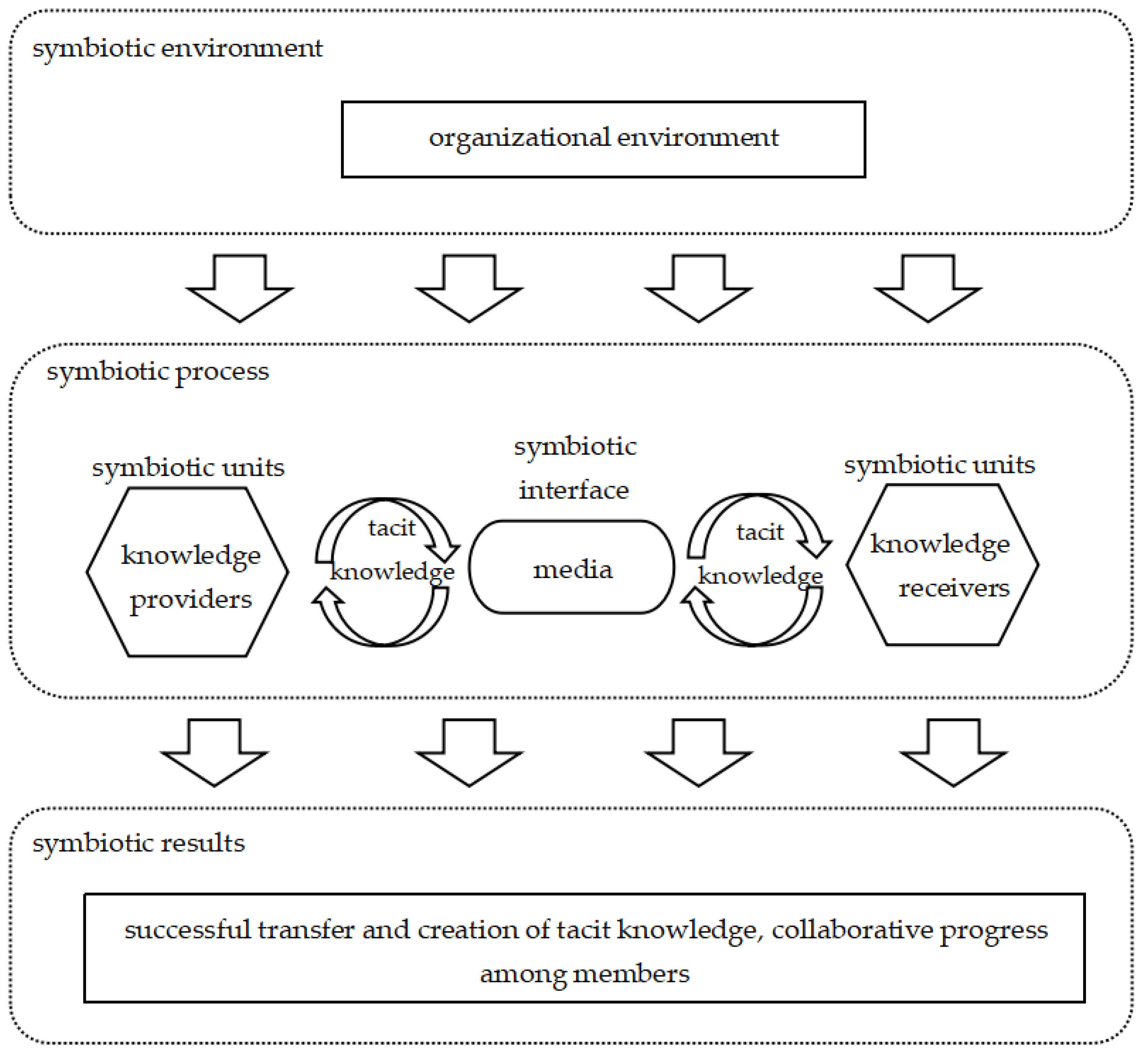
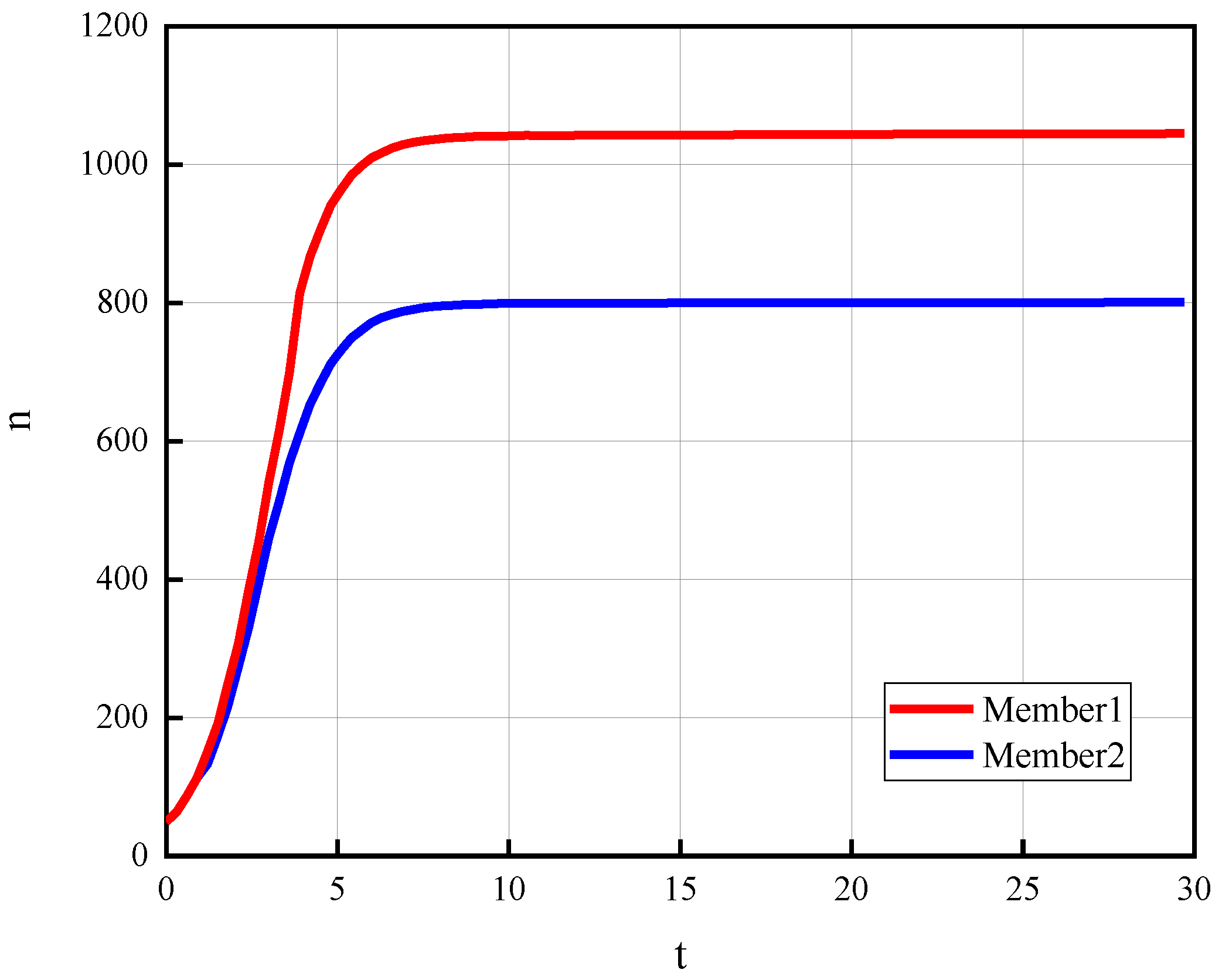
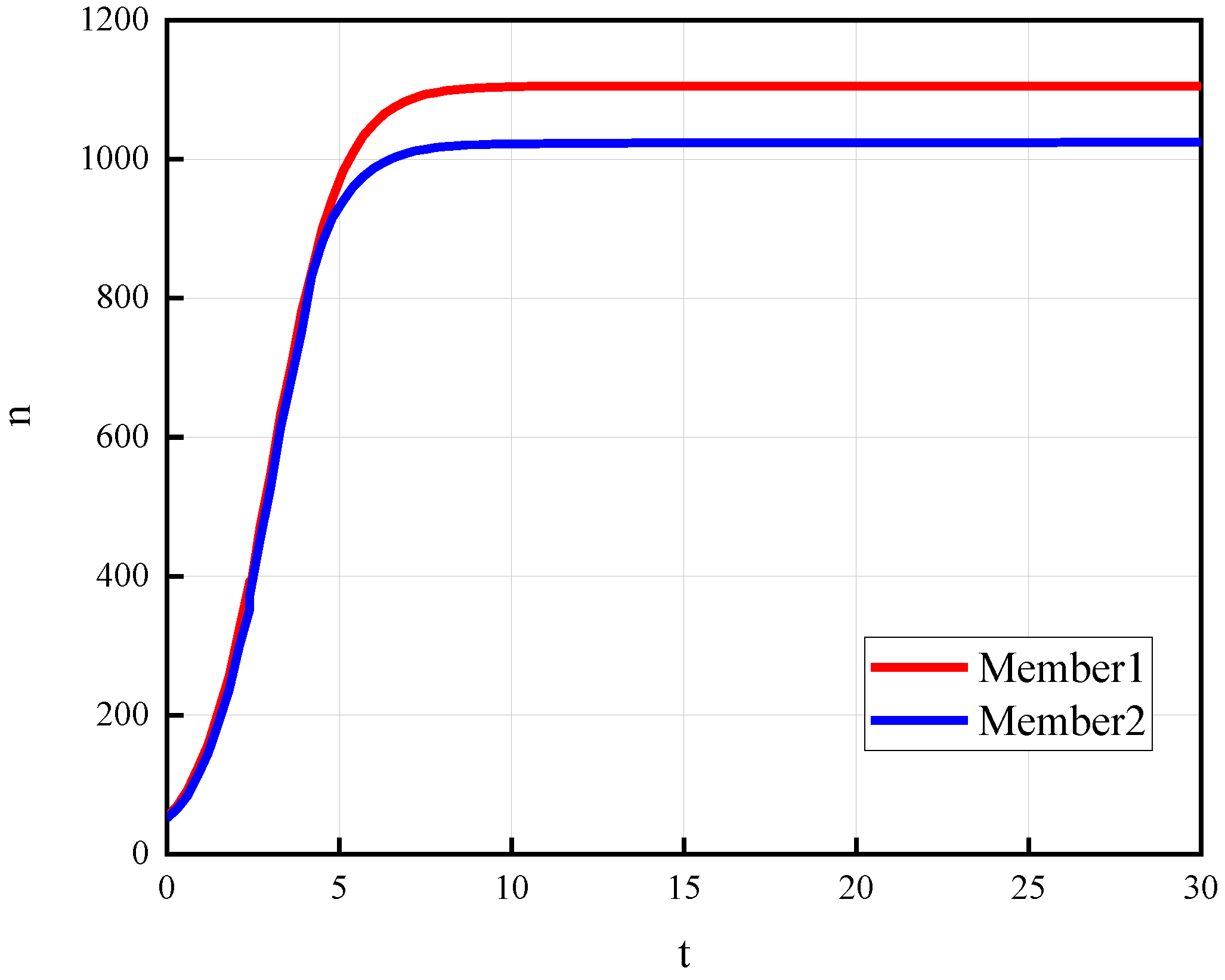

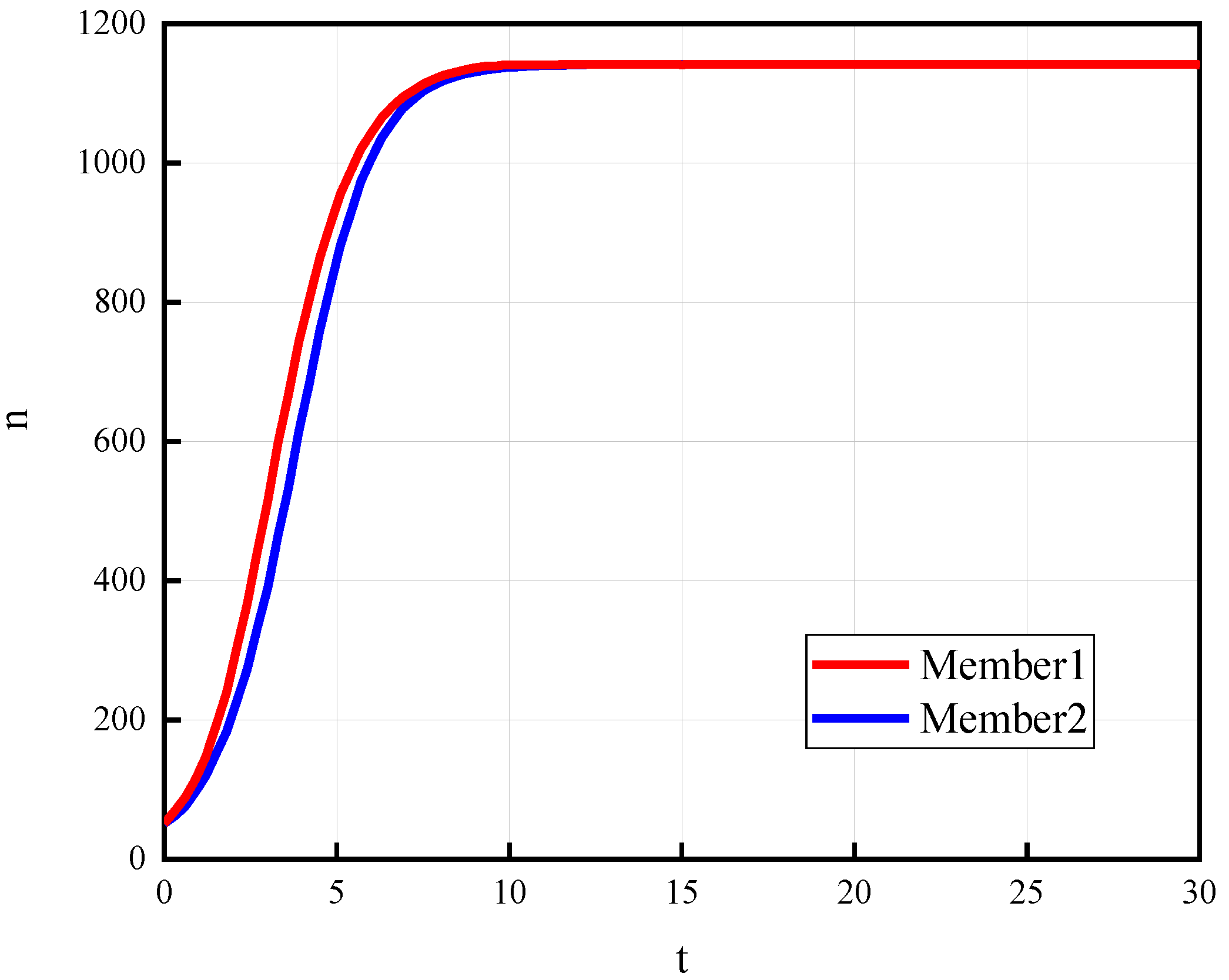
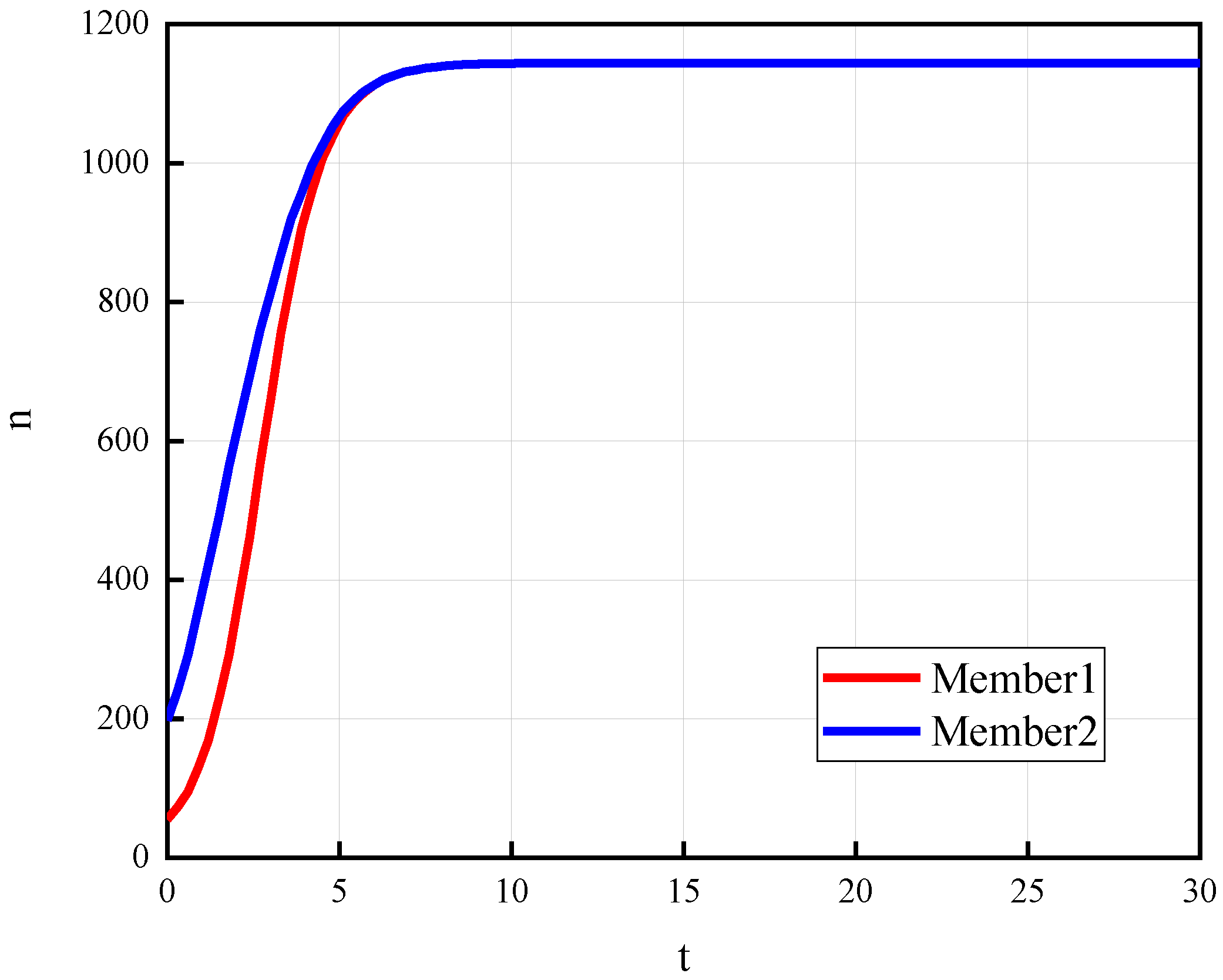
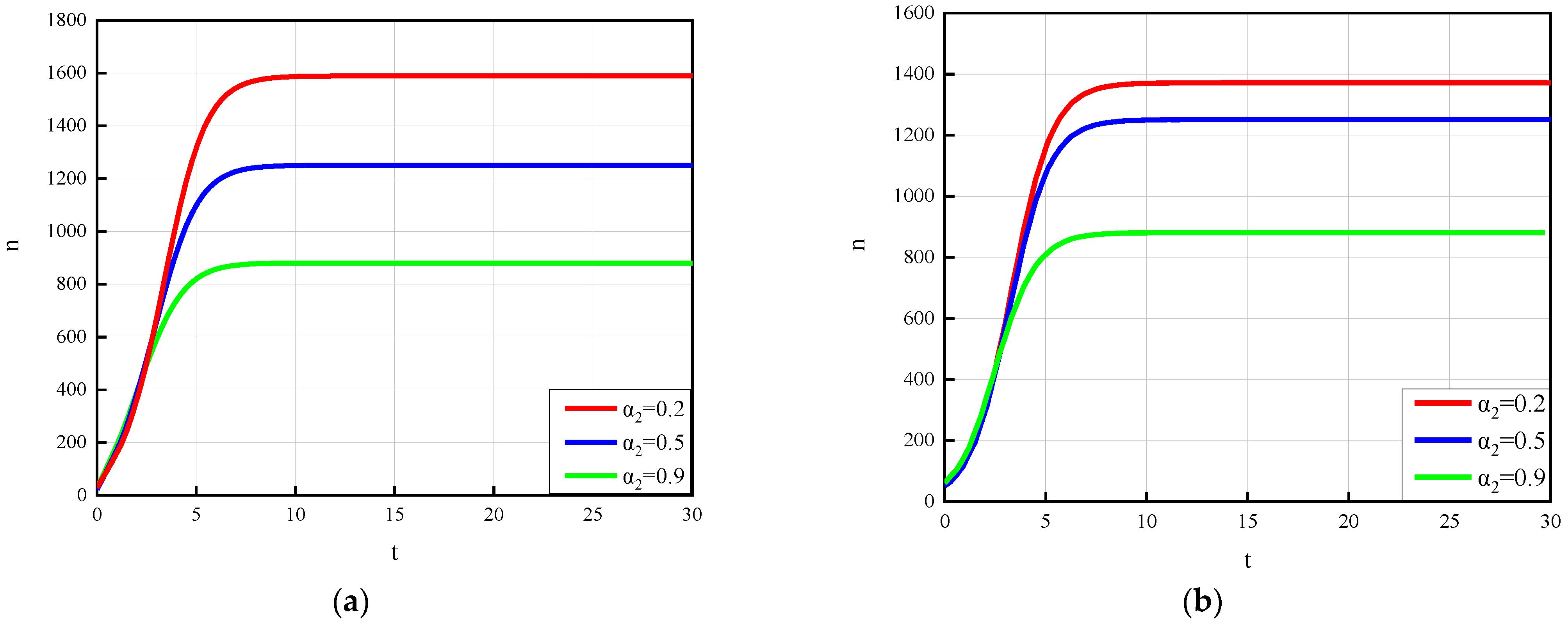
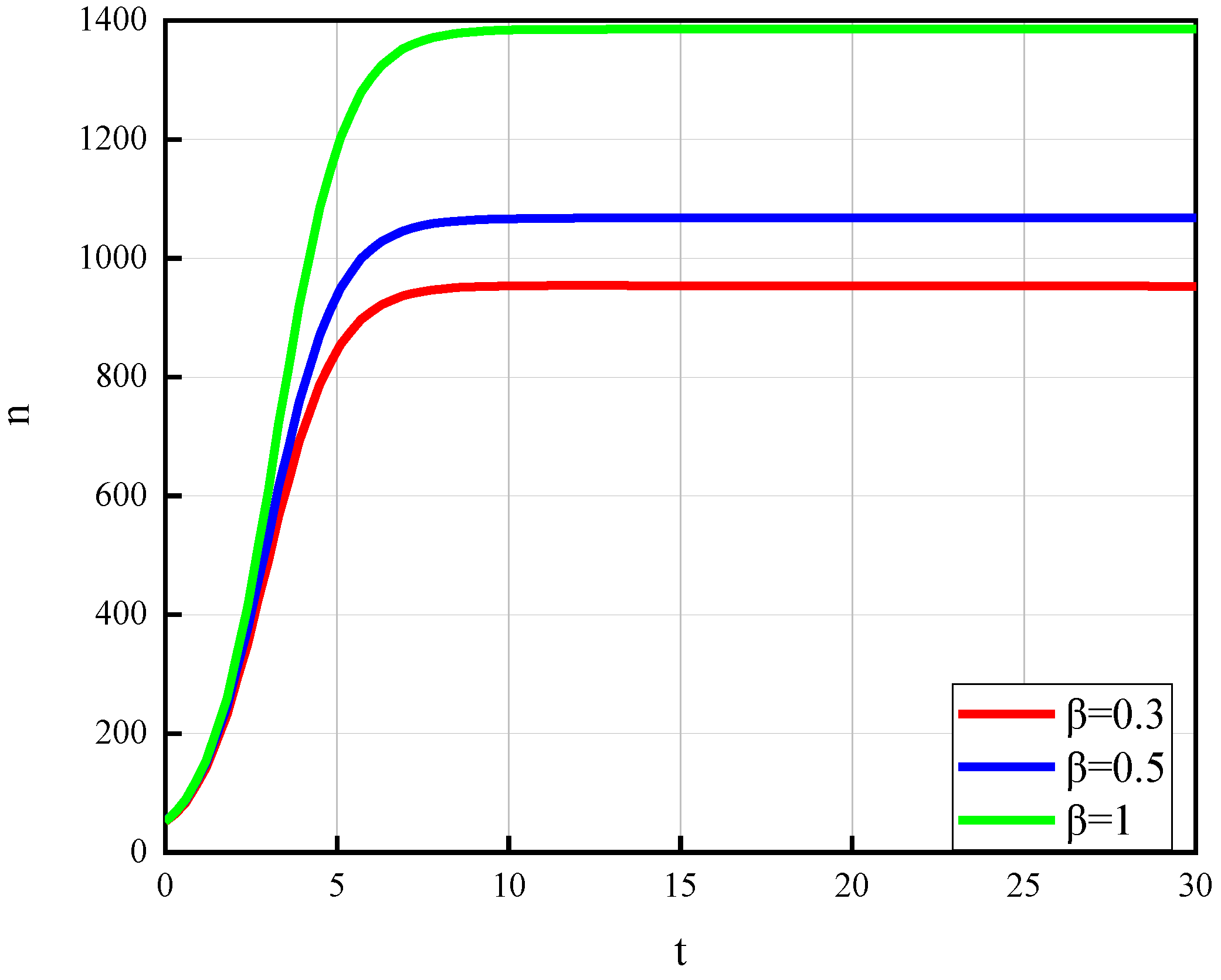
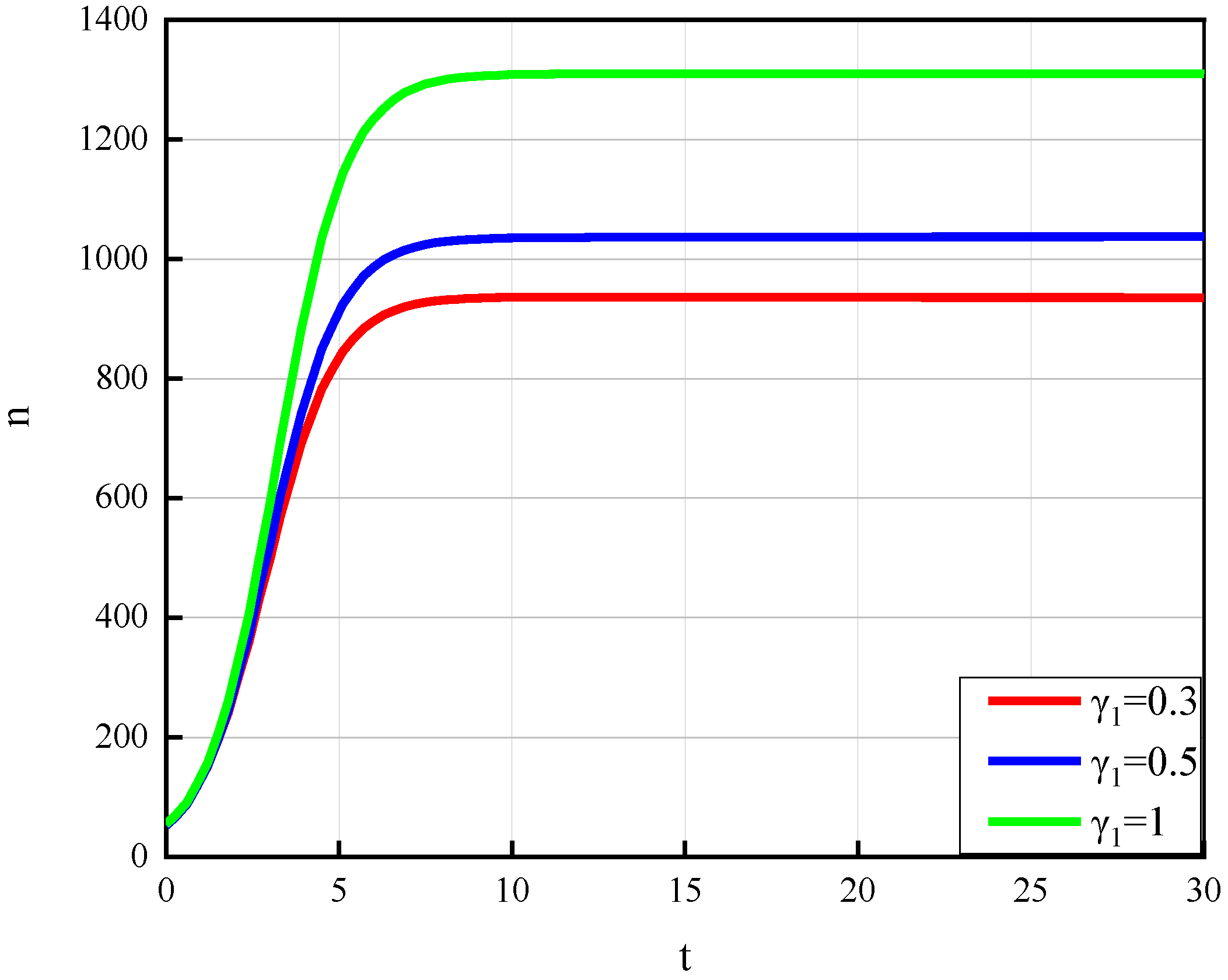
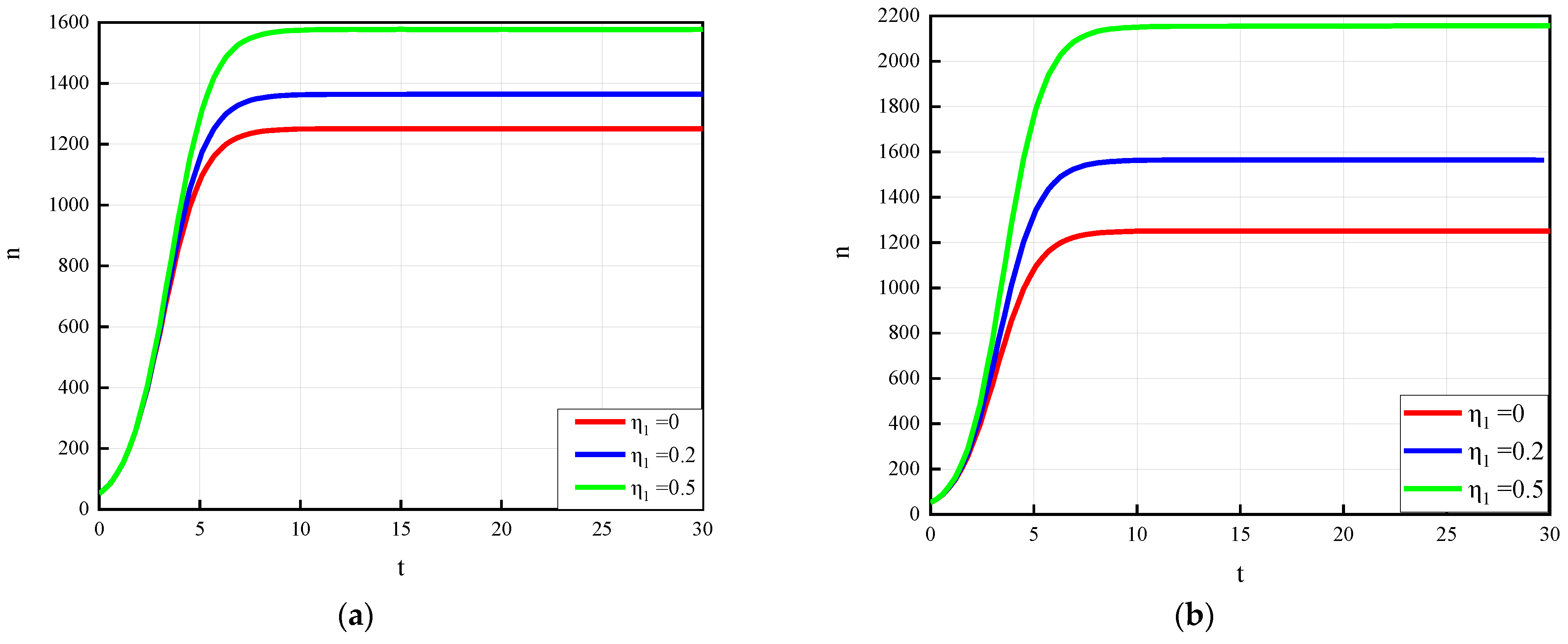
| Equilibrium Points | Det (J) | Tr (J) | Stability Conditions |
|---|---|---|---|
| P1 (0, 0) | Unstable | ||
| P2 (N1, 0) | |||
| P3 (0, N2) | |||
| ) | |||
| Value Combination | Symbiotic Mode | Explanation |
|---|---|---|
| Independence | Members have no impact on each other. Their own resources and conditions determine members’ knowledge growth. Knowledge does not flow in the organization. | |
| or | Commensalism | Members with positive symbiotic coefficient gain, the members with 0 have no change, and the network has no compensation mechanism for non-profit parties. |
| Asymmetric mutualism | There is a wide range of gain in the symbiotic network, and mutual promotion among members, multilateral flow of knowledge, and knowledge resources generally increase, but the symbiotic coefficients lead to different growth rates. | |
| Symmetric mutualism | There is a wide range of gain in the symbiotic network, multilateral flow of knowledge, equal increase of members’ knowledge resources, and synchronization of members’ knowledge growth. | |
Publisher’s Note: MDPI stays neutral with regard to jurisdictional claims in published maps and institutional affiliations. |
© 2022 by the authors. Licensee MDPI, Basel, Switzerland. This article is an open access article distributed under the terms and conditions of the Creative Commons Attribution (CC BY) license (https://creativecommons.org/licenses/by/4.0/).
Share and Cite
Xu, J.; Wu, H.; Zhang, J. Innovation Research on Symbiotic Relationship of Organization’s Tacit Knowledge Transfer Network. Sustainability 2022, 14, 3094. https://doi.org/10.3390/su14053094
Xu J, Wu H, Zhang J. Innovation Research on Symbiotic Relationship of Organization’s Tacit Knowledge Transfer Network. Sustainability. 2022; 14(5):3094. https://doi.org/10.3390/su14053094
Chicago/Turabian StyleXu, Jiang, Huihui Wu, and Jianhua Zhang. 2022. "Innovation Research on Symbiotic Relationship of Organization’s Tacit Knowledge Transfer Network" Sustainability 14, no. 5: 3094. https://doi.org/10.3390/su14053094
APA StyleXu, J., Wu, H., & Zhang, J. (2022). Innovation Research on Symbiotic Relationship of Organization’s Tacit Knowledge Transfer Network. Sustainability, 14(5), 3094. https://doi.org/10.3390/su14053094







